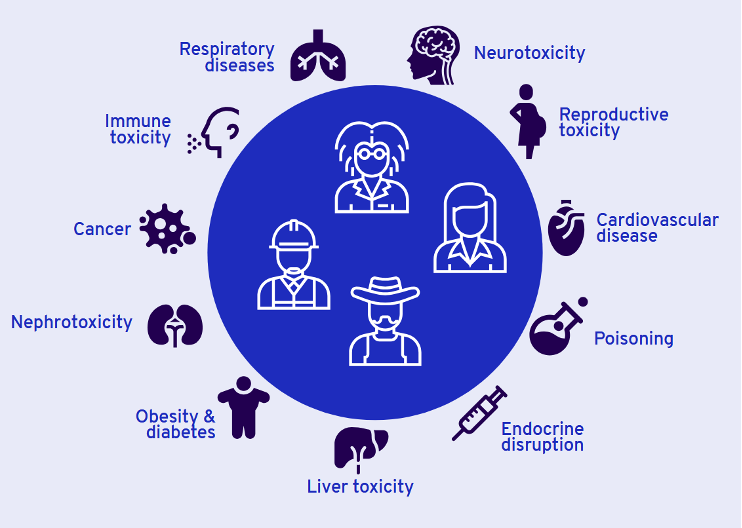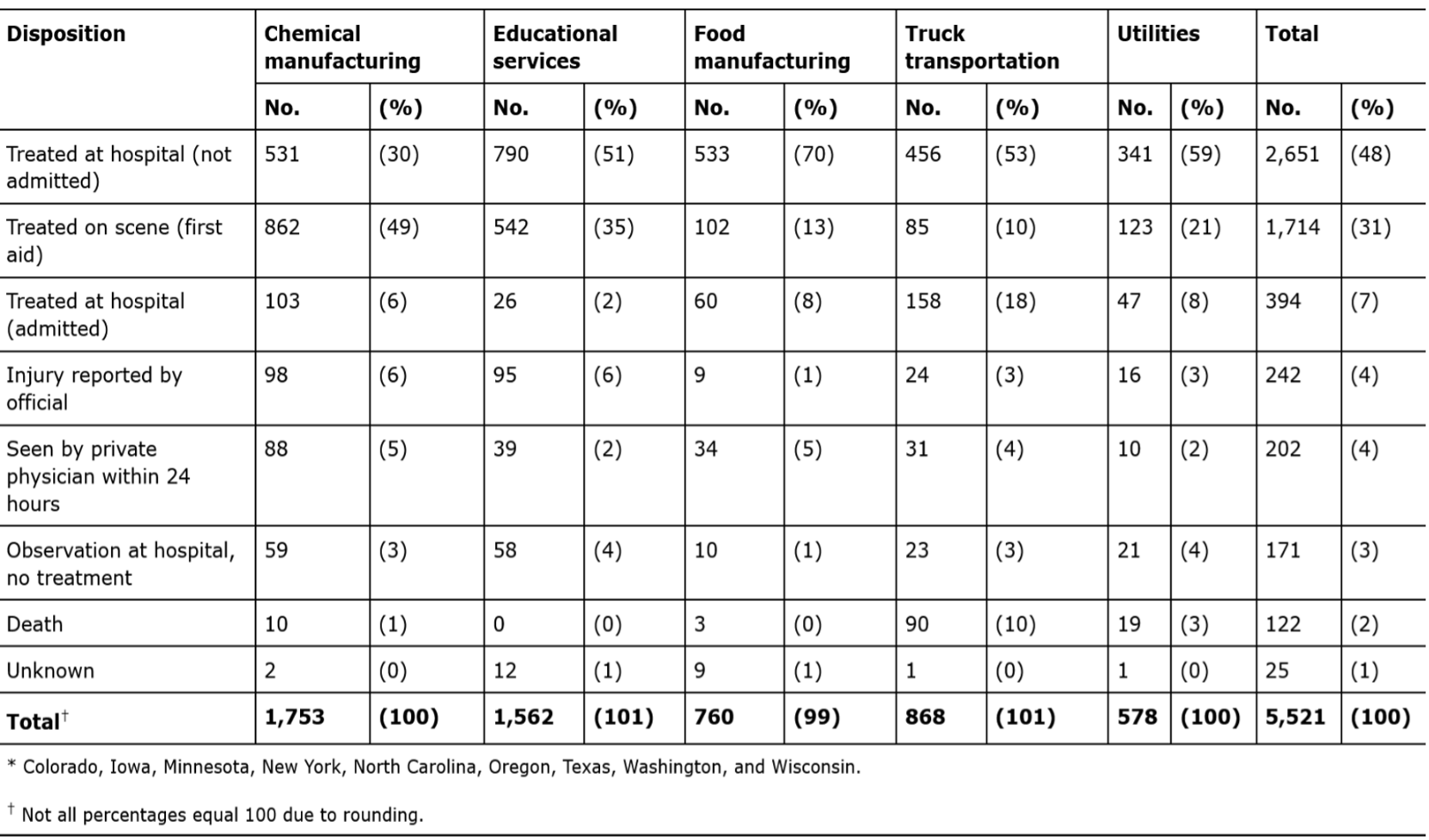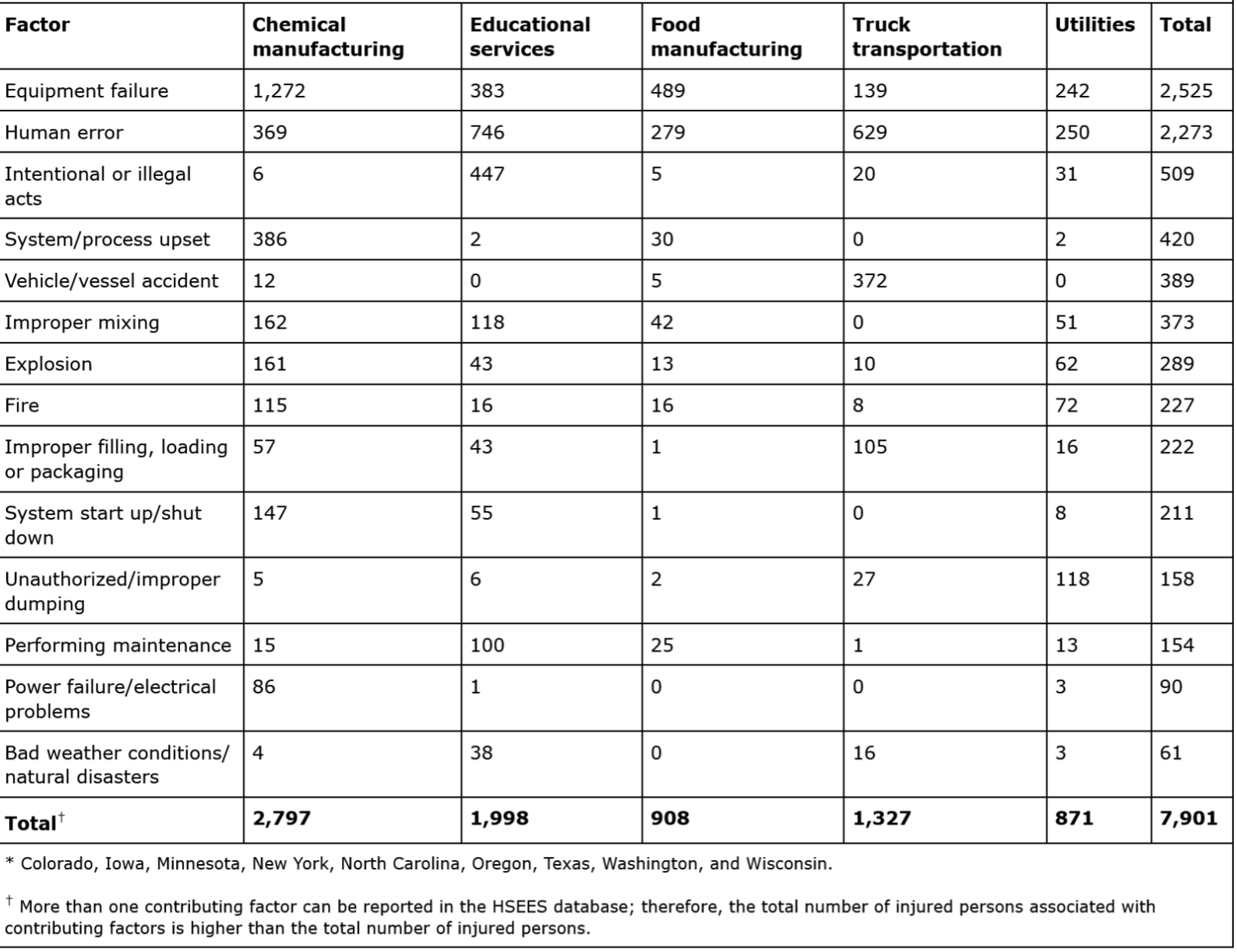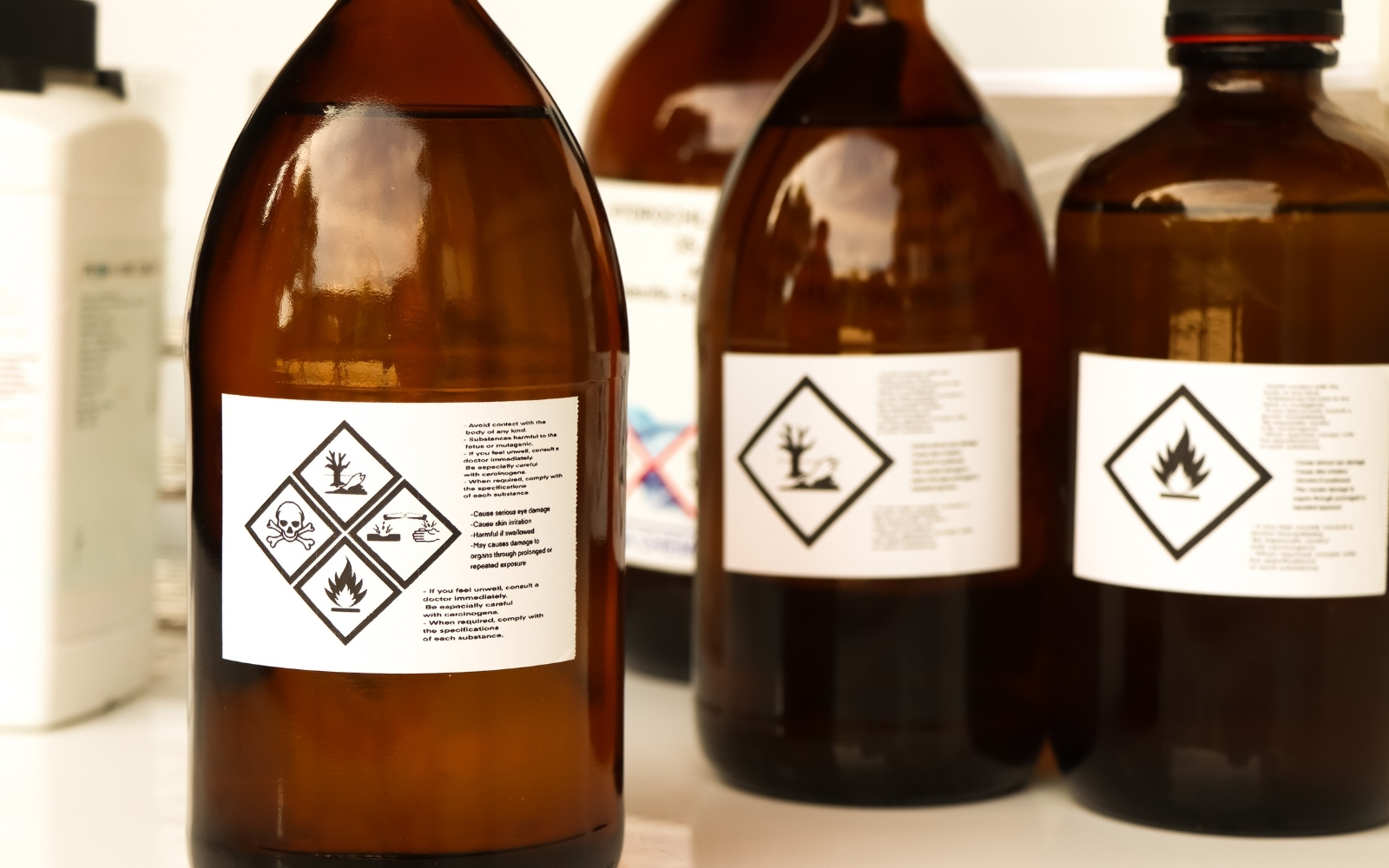- The sectors most affected by chemical hazards vary depending on the region or country.
- In the USA, according to the number of injuries, the industries worst affected by chemicals are chemical manufacturing, educational services, truck transportation, food manufacturing, and utilities.
- In France, according to reported risks, the five most affected sectors are workers in construction, manufacturing, healthcare and social services, vehicle trade and repair, and transport, storage, and public sectors.
According to the International Labour Organization, each year, a billion workers around the globe are exposed to hazardous chemicals at their workplace, leading to fatalities, illness, and injuries, all of which are preventable. While industries have made significant progress in mitigating the dangers posed by chemicals, the number of people harmed remains alarmingly high. Industries differ in the occupational hazards they face due to chemicals, and some are more prone to risks. In this article, we discuss the sectors that are most affected by chemical hazards.
Occupational Hazards Due to Chemicals
Chemical production and use are increasing across industries, so workers continue to face significant exposure to their hazards. Acute and chronic exposure leads to illness, poisonings, fatal diseases, and cancers, as well as injuries and death due to fires and explosions. Industrial accidents also harm surrounding communities and the environment.
The chemicals also lower economic prosperity, causing losses amounting to 2.1% of the global Gross Domestic Product each year.
Annually, one million workers die, and several million suffer from chronic illness due to exposure to hazardous chemicals. The primary chronic illnesses resulting from chemical exposure are respiratory, cardiovascular, and genitourinary diseases, as well as malignant neoplasms and neuropsychiatric conditions; see Figure 1 for the various health problems associated with toxic chemical exposure. Cancer is the leading cause of mortality from chronic chemical exposures to over 200 substances that are known or probable human carcinogens.
The people affected most are vulnerable groups like migrant workers, Indigenous people, women, and children.
Reliable data on the local, regional, and global occurrence of most chemical occupational hazard exposures and the number of people affected are missing. Having this data can improve national and international policy responses. The sectors most affected by chemical occupational hazards vary by region.

Figure 1: The health problems caused by chemicals lead to deaths, injuries, and illness, ILO. (Credits: https://www.ilo.org/sites/default/files/2024-07/wcms_811455%20%284%29.pdf)
In France
A 2022 study in France found that workers in the construction sector were the ones most affected by chemicals, with 75% reporting risks. This was followed by 59% in manufacturing, 39% in health and social facilities, 35% in trade and repair of vehicles, and 25% of workers in the public sector, transport, and storage. The two industries with the most exposure to chemicals are construction and manufacturing, as workers frequently handle chemicals as part of their job duties.
- Construction staff are exposed to various chemicals, including solvents, adhesives, and cleaning materials. Workers are exposed to dust and fumes from building materials, such as asbestos, as well as tasks like cutting and sanding materials.
- Manufacturing sector workers are also exposed to fumes and dust, but more to gases, chemicals, and cosmetics while handling materials.
- Healthcare workers are exposed to drugs, cleaning and sanitizing agents, and laboratory reagents.
- Vehicle repair personnel are exposed to chemicals, dust, and fumes. Skin contact with glue, waste oils, sealants, and toxic cleaning materials can cause illness. Exhaust or carbon monoxide fumes, dust during retreading and tire buffing are other sources of chemical exposure.
- Storage and transport staff work with cleaners and solvents, and are exposed to smoke and dust during travel.
Some common industries, such as the transportation industry, also suffer the most from chemical hazards in the USA.
In the USA
A 2015 report by the Hazardous Substances Emergency Events Surveillance (HSEES) system, based on data collected between 1999 and 2008 from health departments of nine states in the USA, identified the top five industries affected by chemical hazards. The information was collected to identify areas where chemical hazards have occurred and those with a potential for future occurrences, to prevent morbidity and mortality. The report is based on registered acute chemical incidents. Events that resulted in injuries, illness, or death within 24 hours of a chemical-related accident were considered an acute incident.
Between 1999 and 2008, 57,975 hazardous chemical incidents were reported in the nine states, of which 4,621, or 8%, resulted in injuries to 15,506 persons. According to this HSEES report, five industries- chemical manufacturing, truck transportation, utilities, food manufacturing, and educational institutions accounted for one-third of all injuries; see Table 1. Around 2% of the injuries resulted in fatalities in the nine states during 1999-2008 due to chemical hazards.
TABLE 1. “Number and percentage of persons injured for top five industries, by disposition of injured person — Hazardous Substances Emergency Events Surveillance system, nine states, * 1999–2008,” Wu 2015. (Credit: https://www.cdc.gov/mmwr/preview/mmwrhtml/ss6402a7)

Chemicals, including gases, fumes, particles, aerosols, and other substances, are a leading cause of work-related injuries and deaths. Indoor pollution also occurs in workplaces. The substances that pose a risk will vary depending on the industry. However, due to their chemical properties, chlorine, ammonia, carbon monoxide, hydrochloric acid, and sulfuric acid are some commonly reported causes in the five top industries affected in the USA.
The five industries that reported the most incidents also had the highest number of injuries.
- Chemical manufacturing, involving the production of chemicals from organic and inorganic raw materials, reported the highest number of acute injuries, 1753 persons, and the third highest number of fatalities (10 deaths). Equipment failure was the number one cause of hazards in chemical manufacturing facilities. Ammonia was the main chemical released in this sector.
- Educational services included training centers, schools, and universities. They had the second-highest number of injuries, 1562, with sulfuric acid the number one cause of hazards. This sector had the highest number of evacuations.
- The truck transportation subsector, which involves cargo transport through trucks and trailers, injured 869 workers, but had the highest mortality, 90 people, primarily due to trauma during a chemical release. Human error and vehicle accidents were the leading causes of danger for transporters, who need to be aware of the chemicals and the associated hazards of the goods they carry. Clear and legible labeling is also recommended. Hydrochloric acid releases occurred the most during truck transportation.
- Food manufacturing, which includes agricultural and livestock production, came fourth in the number of injuries, along with three fatalities due to chemical hazards. Human error was the primary reason for chemical accidents, and ammonia was the most significant chemical hazard.
- Utilities include services like electric power, water supply, natural gas, steam supply, and sewage removal systems. They had 578 injuries and the second-highest number of deaths (19 fatalities). The main factor was human error, and the causal chemical was chlorine.
See Table 2 for details on causes for chemical accidents in the five industries. Equipment failure and human error are the two leading causes of injuries and fatalities in these industries.
In 2017, 41 people died after a single incident of chemical inhalation, and there were 297 fatalities between 2011 and 2017 in the whole country.

Table 2: “Number of persons injured, by associated contributing factors and top five industries — Hazardous Substances Emergency Events Surveillance system, nine states, * 1999–2008,” Wu 2015. (Credit: https://www.cdc.gov/mmwr/preview/mmwrhtml/ss6402a7)
Chemical Hazard Prevention and Preparedness
Several methods are employed to minimize chemical releases and prevent accidents in industries. The hierarchy of controls recommended by the Occupational Safety and Health Administration is widely used as a model for preventing and minimizing risks. It includes elimination, substitution, engineering controls, administrative controls, and the use of personal protective equipment.
One vital engineering control for reducing chemical hazards is monitoring their levels through gas detectors in the atmosphere, especially for gases, many of which are colorless and difficult to detect, unlike liquids or solids. The gas detectors ensure that workers are protected from gases that exceed the permitted limits. If any gas exceeds safe limits, the devices provide warnings through audio and visual alarms, alerting staff to impending danger and allowing for timely evacuation to save lives and take necessary remedial measures to prevent the situation from escalating. Interscan offers fixed 24/7 monitoring solutions and portable devices for high-risk areas and confined space checks, detecting over 20 gases, including chlorine, ammonia, carbon monoxide, hydrochloric acid, and sulfuric acid, which are commonly found in the USA.
Contact us at Interscan to learn how our gas detectors can prevent chemical hazards in your facilities.
Sources
Bureau of Labor Statistics, U.S. Department of Labor. (2019, Oct 24). The Economics Daily, Fatal chemical inhalations in the workplace up in 2017. Retrieved at https://www.bls.gov/opub/ted/2019/fatal-chemical-inhalations-in-the-workplace-up-in-2017.htm.
Dogbla, L., Gouvenelle, C., Thorin, F., Lesage, F. X., Zak, M., Ugbolue, U. C., Charbotel, B., Baker, J. S., Pereira, B., & Dutheil, F. (2023). Occupational Risk Factors by Sectors: An Observational Study of 20,000 Workers. International journal of environmental research and public health, 20(4), 3632. https://doi.org/10.3390/ijerph20043632
IISD. (2023, Sept). The Sound Management of Chemicals and Waste: At the Heart of the Right to a Safe and Healthy Working Environment. Retrieved from https://enb.iisd.org/sound-management-chemicals-waste-safe-healthy-working-environment
ILO. (2021, May 17). Workers around the world face a global health crisis due to occupational exposure to toxic chemicals. Retrieved from https://www.ilo.org/resource/news/workers-around-world-face-global-health-crisis-due-occupational-exposure
ILO. (2023, Nov 26). Nearly 3 million people die of work-related accidents and diseases. Retrieved from https://www.ilo.org/resource/news/nearly-3-million-people-die-work-related-accidents-and-diseases.
ILO. (2023). Exposure to hazardous chemicals at work and resulting health impacts: A global review. Retrieved from https://www.ilo.org/publications/exposure-hazardous-chemicals-work-and-resulting-health-impacts-global
Wu, J. (2015, April 10). Top Five Industries Resulting in Injuries from Acute Chemical Incidents — Hazardous Substance Emergency Events Surveillance, Nine States, 1999–2008. Retrieved from https://www.cdc.gov/mmwr/preview/mmwrhtml/ss6402a7.htm


